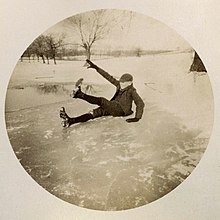Slipperiness is when a surface has a low coefficient of friction, allowing objects to glide across the surface. People walking on slippery surfaces are likely to sliporfall. A surface can for example be slippery due to it being wet, or due to it being icy. There are several competing theories about why ice is slippery.


Road slipperiness is a major area of road safety, but various means have also been developed to measure walkway and deck slipperiness in order to develop health and safety standards.[1]
This classical mechanics–related article is a stub. You can help Wikipedia by expanding it. |